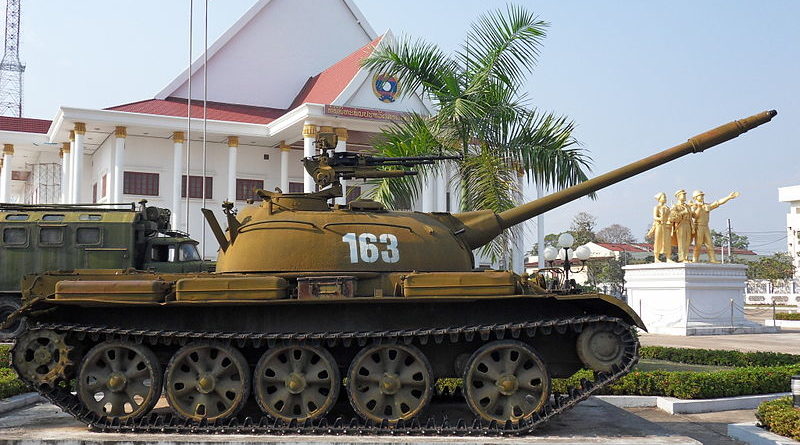Laos Continues To Deepen Military Ties With Russia But Risks Chinese Backlash
Source: ASEAN today
On January 20, Russian tanks and armored cars drove through the streets of the Lao capital of Vientiane. The tanks were the new centrepiece of a military parade to honour the 70th anniversary of the founding of the Lao People’s Armed Forces (LPAF). Laos purchased the military equipment from Russia as a part of a deal reached in January of last year, when Russian Defense Minister Sergey Shoigu visited Lao Prime Minister Thongloun Sisoulith and Minister of Defense Chansamone Chanyalath.
It’s unclear what Laos is paying for the defence contracts, but they offer the country few advantages. Laos has no need for a stronger military and, as one of ASEAN’s lowest-income countries, the government could put the money to far better use.
Some sources also suggest that Laos may be offering Russia other guarantees in lieu of payment. This isn’t new territory for Russian arms deals. The two countries have had military ties since the Soviet Union began supporting the Pathet Lao government in the 1960s. The Kremlin’s role in Laos is smaller today, but the deals still represent a risk as China may see them as a threat to its influence over the republic.

Russian arms deals offer Laos a chance to balance Chinese influence
After his visit with Shoigu last January, Prime Minister Thongloun publicly remarked
that “everything the Laotian Armed Forces now have is linked with
Russia.” As the Kremlin works to expand its influence in Southeast Asia,
ASEAN countries have a chance to reduce over-reliance on the US or
China, bringing in a “third pole” ally.
Recently, China has been Laos’ biggest patron – albeit a predatory one. China has saddled Laos with debt as Laos takes on numerous hydropower mega-dams and other projects as part of China’s One Belt-One Road Initiative. The high-speed railway from Kunming to Vientiane, for example, is costing US$6 billion. The project has also already displaced 4,400 people since construction began in 2016, without delivering compensation to those affected.

Thanaleng station near Vientaine, the new high speed line from Kunming (China) will go through this station.
Photo Credit: Shankar S./Wikimedia Commons
Laos currently owes more than 68% of its gross domestic product (GDP) in debt. Around half of this public debt is to China, and that number is growing. The World Bank has recommended that Laos limit its debt to no more than 40% of its GDP, while the International Monetary Fund (IMF) was a little more forgiving, suggesting a limit of 50%.
China is already using debt as a means to control the small nation. When Laos failed to pay back a US$80 million loan from China for the construction of a stadium for the Southeast Asian games, the governments reached an agreement whereby Laos granted a 300-hectare land concession to a Chinese company.
Despite this, Prime Minister Thongloun said last year that he is “not concerned much about the burden of debt.” Laos could increase ties with Russia as a strategy to check Chinese influence, but this will backfire if it turns Laos into a battleground for soft power.

Laos has a better chance of checking Chinese influence by confronting
the problem head-on – negotiating better terms for new and existing
partnerships, that leave Lao people with more control of their land,
resources and economy. This might require turning to the international
community for support, to counterbalance China’s leverage in the Lao
economy, but this is a more pragmatic option than wasteful arms deals.
Laos continues to take on larger defence contracts with Russia, but these come with concessions
Lao and Russian officials have tried to keep the size of the new arms deals under wraps but it appears that they represent an expansion of military ties between the nations. An anonymous source with the LPAF said that the latest shipment consisted of “several dozen” T-72B tanks. The deal also included Russian YAK 130 fighter jets and four Mi-17 helicopters from Russian state-owned firm Rostec, which they delivered to Laos last July. The deal also secured Russian artillery for the LPAF and a contract for Russia to service some of the LPAF’s older helicopters, as well as granting the Russian Defense Ministry permission to open an office in Vientiane.
Laos has also recently delivered a fleet of 30 aging Soviet tanks back to Russia,
for use in Russia’s own parades commemorating victories in World War
II. The vintage model T-34 tanks played a key role in battles against
the Nazis before they were turned over to Laos during the Cold War.
Their presence in Laos are a relic of Soviet support for the Prathet
Lao. But it’s unlikely that they account for a substantial portion of
the payment for Laos’ new state-of-the-art arms.
One source close to a high-ranking Lao military officer told
Radio Free Asia that the weapons cost “many millions of U.S. dollars,
with the Lao government giving Russia the concession of mining and
development projects in exchange.” Russia has a history of pursuing
mining in Laos and maintained mining operations across Savannakhet province in southern Laos throughout the 1980s.
If this is how Laos intends to pay for Russian arms, there are better
deals out there. As a part of contracts to sell arms to Indonesia,
Russia has committed
to buying coffee, tea and palm oil from the country. While these deals
can be exploitative in their own right and have devastating
environmental and economic impacts, it’s less risky than yielding
natural resource rights to a foreign power.
When Moscow calls, Vientiane doesn’t need to ask for arms
If Laos hopes to balance Beijing’s power, the Lao government would be better off focusing on more equitable development and agreements that don’t include arms. There are already agreements of this nature in place. One example is the partnership between Russia and Laos under which the Russian military is helping to clear rural areas in Laos of unexploded ordnance (UXO) left from the US bombing in the 1960s and 70s. Russia established its International Anti-Mine Center in Khamkeut district in November 2018, and this month the Russian military reported that they’ve cleared 52 hectares of mines.

Lao exports to Russia total only US$1.5 million and consist mostly of coffee and textiles. By comparison, Laos imports US$14.2 million from Russia, largely made up of paper goods and tech. If Laos hopes to counterbalance China’s influence, bolstering trade would be a less threatening and more beneficial alternative to arms deals.
Arms sales are key to the Kremlin’s ties to ASEAN, but not to Laos
Russian arms have long been a key part
of its role in Southeast Asia. Russia sells more arms to ASEAN than the
US or China. From 2010 to 2017, sales by Russian defence firms to ASEAN
countries totalled US$6.64 billion, representing 12% of Russia’s arms sales globally. The US, by comparison, sold US$4.58 billion
in arms to ASEAN in the same period, accounting for 6% of total US arms
sales. Not only does Russia sell more weapons to ASEAN, but those sales
represent a larger share of Russian defence companies’ contracts.
Russia also plans to take part in ASEAN joint navy exercises in 2019. China sells far fewer arms in the region – a total of only US$1.8 billion, 2010-17.
Arms sales to Laos, however, are only a small piece of the picture
for both Russia and China. Less than 1% of the arms Russia sells to
ASEAN go to Laos. China has also sold relatively few arms to Laos, with 66%
of Chinese arms sales in ASEAN from 2010 to 2017 going to Myanmar. At
this stage, Laos stands a good chance of being able to pivot away from
defence contracts without facing a backlash from either power.
Laos may be hoping to increase ties to Russia in order to check Beijing’s increasing domination of the Lao economy. The Chinese presence in Laos is already setting the economic agenda, while also tieing Laos to Beijing politically. But if Laos continues to purchase large quantities of arms from Russia, China may respond by tightening controls on the Lao economy or leveraging Laos’ growing Chinese debt.
By replacing Russian arms deals with equitable trade agreements and initiatives that meet Laos’ more pressing needs, Vientiane and Prime Minister Thongloun could secure more benefits for Laotian people, while still balancing Chinese influence.

